Nowadays we hear “cloud’’ everywhere IoT comes into the picture. In many cases it seems like the “cloud” is being presented as the solution to all things in IoT projects. The reality is that it is not possible, cost effective or desirable to transmit every piece of data from our devices to the cloud in order to gain value from the data. A true IoT architecture needs to recognize and embrace the highly distributed nature of the IoT and enable data processing at the edge as well as the cloud.
An IoT software platform must provide a software architecture that matches that reality. Software functions need to be able to reside at every level of the architecture from the “edge” — on an equipment system, in an electrical closet or in a BMS integration unit, to the building level — where data from multiple smaller nodes can be aggregated and analyzed, to the cloud where data analysis occurs at a portfolio level. Reengen Edge Analytics Module (REAM) provides this capability. REAM allows hundreds of nodes to be connected in unified, near-seamless systems. Data collection, storage, management, analytics processing and visualization functions are performed by the individual nodes at whatever level they are deployed, while user applications that present data and analytics results to users work as if the system were one, single unified server.
Data center class Compute & Analytics will shift left to the edge
By implementing a true distributed architecture, REAM provides numerous benefits, which directly address needs of IoT applications including:
Local data collection ensures reliability
Network issues, can interrupt data collection in cloud-dependent systems, resulting in loss of critical data. Data collection services operating at the edge insure that data is collected by the local node where the risk of communication issues is far lower. The system still provides for synchronization of data (via replication) to enable access at the cloud level without the need for real time communication to edge devices.
Lower data transfer costs
In addition to reliability, REAM’s distributed architecture provides optimized synchronization of data with the cloud, which can dramatically reduce data transfer costs in systems that rely on cellular networks for continuous transmission of data to the cloud for processing. Typical user requests for data and visualizations are directed to the most recent “replica” instead of initiating requests over the network. The reduction in network usage can be dramatic.
Simpler implementation
With only one platform to learn and one set of software tools to work with, the result is faster development, an easier learning curve, and more reliable applications.
A Simpler user experience
The fact that data and processing is distributed across multiple nodes is a complexity to be hidden from the average user. REAM allows them to navigate their world as if it were a singular system. They choose to look at projects, sites, buildings, or equipments — navigating by whatever logical entities make sense for their application. REAM provides a streamlined, near seamless user interface across distributed systems.
Many Options for Deployment at the “Edge” In order to be effectively applied at the edge costs have to be competitive. REAM software has been designed to run in everything from a small low cost device the size of a deck of cards, to server clusters hosted in the cloud. Throughout the architecture Reengen Energy IoT Platform provides the exact same software architecture, data model, functions and features. With the advent of new IoT gateway hardware options, systems integrators and system designers have greater choice in the hardware they use, reducing risk of vendor lock-in and insuring competitive pricing. With minimum processor specifications, REAM can be deployed on a wide range of standard, easily available, low cost edge devices with Linux OS such as Raspberry Pi 3.
REAM brings Data Collection, Analytics and Visualization to the Edge
A key consideration in implementing IoT solutions is the location of data collection, logging, storage and analytics processing. Real-time applications cannot be served with the latencies involved in transmitting data to the cloud for processing and analytics. REAM enables data collection, storage, management, analytics and visualization to be performed by the edge device. Operators can view comprehensive data and analytic presentations served directly by Reengen Energy IoT Platform operating in the edge node. They do not have to access a cloud host outside of their facility. This capability can be an important factor to address security concerns in mission critical applications, as well as real time applications. Reengen Energy IoT Platform is also unique in that it brings the analytics processing to the data. With the Energy IoT Platform, the analytics engine runs where the data source is as opposed to being a separate process dependent on delivery of data sets pulled from a database. This enables the platform to deliver high-speed, continuous analysis of data — including streaming data.
